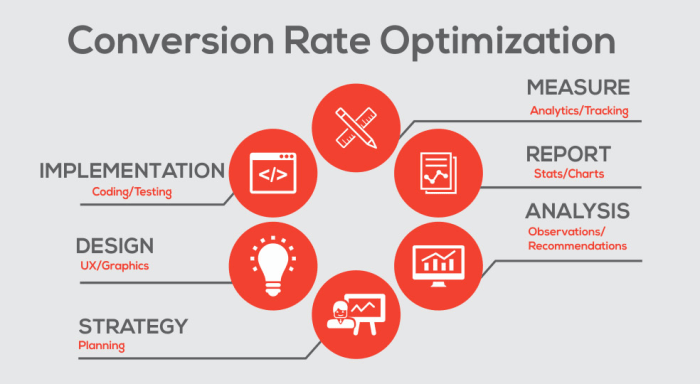Optimizing Conversion Rates is the key to unlocking greater success for businesses, as we delve into strategies that drive growth and profitability.
Understanding user behavior, enhancing design and user experience, and utilizing A/B testing are just a few areas we’ll explore in this exciting journey towards maximizing conversions.
Introduction to Conversion Rates Optimization

When it comes to business, conversion rates are like the MVPs – they measure the percentage of website visitors who take a desired action, whether it’s making a purchase, signing up for a newsletter, or filling out a contact form. Basically, it’s all about turning those casual browsers into paying customers or leads.
Optimizing conversion rates is crucial for businesses because it directly impacts the bottom line. By increasing the percentage of visitors who convert, companies can boost revenue, improve ROI, and grow their customer base. It’s all about maximizing the effectiveness of your website or landing page to drive more conversions without necessarily increasing traffic.
Successful Conversion Rate Optimization Strategies, Optimizing Conversion Rates
- Personalization: Tailoring the user experience based on individual preferences and behavior can significantly increase conversion rates. Companies like Amazon and Netflix do this masterfully, recommending products or content based on past interactions.
- Clear Call-to-Actions: Having clear, compelling CTAs that guide visitors towards the desired action is key. Whether it’s a “Buy Now” button or a “Sign Up” form, making it easy for users to take the next step is crucial. Just look at how Uber simplifies the booking process with a single button tap.
- A/B Testing: Testing different variations of elements on a webpage to see which one performs better is a common CRO practice. By analyzing data and making data-driven decisions, companies can continuously improve their conversion rates. Google famously tests everything from doodles to search result layouts.
Understanding User Behavior
Understanding user behavior is crucial in optimizing conversion rates because it allows businesses to tailor their strategies to meet the needs and preferences of their target audience. By analyzing how users interact with a website or app, businesses can identify areas for improvement and optimize the user experience to increase conversions.
One way to analyze user behavior is by tracking user data to identify conversion bottlenecks. These bottlenecks are points in the user journey where potential customers are dropping off or abandoning the conversion process. By pinpointing these bottlenecks, businesses can make targeted improvements to increase conversion rates.
Tools and Techniques for Tracking User Behavior
- Google Analytics: This tool provides valuable insights into user behavior on a website, including traffic sources, user demographics, and behavior flow.
- Heatmaps: Heatmap tools like Crazy Egg or Hotjar visually represent how users interact with a website, showing where users click, scroll, and spend the most time.
- User Surveys: Conducting surveys can provide direct feedback from users about their experience on a website, helping identify pain points and areas for improvement.
- A/B Testing: This technique involves testing different versions of a webpage to see which performs better in terms of conversion rates, helping businesses make data-driven decisions.
Design and User Experience: Optimizing Conversion Rates

When it comes to conversion rates, website design and user experience play a crucial role in influencing whether visitors take action or bounce off your site. A well-designed website that provides a seamless user experience can significantly impact conversion rates.
Optimizing Website Design
- Ensure a clean and visually appealing layout that is easy to navigate.
- Use clear call-to-action buttons that stand out and guide users towards the desired action.
- Optimize loading times to prevent users from getting frustrated and leaving the site.
- Implement responsive design to ensure your website looks great and functions well on all devices.
- Utilize high-quality images and engaging visuals to capture user attention.
Impact of Mobile Responsiveness
Mobile responsiveness is crucial for conversion rates, as more and more users are accessing websites on their smartphones and tablets. If your site is not optimized for mobile devices, you could be losing out on potential conversions. It’s essential to ensure that your website is responsive and provides a seamless experience across all devices to maximize conversion rates.
A/B Testing and Data Analysis
A/B testing is a crucial method used in conversion rate optimization to compare two versions of a webpage or app to determine which one performs better in terms of achieving the desired goal, such as increasing sign-ups or purchases. By conducting A/B tests, businesses can gather data-driven insights to make informed decisions on optimizing their conversion rates.
Setting Up and Conducting A/B Tests
- Identify the goal: Clearly define what you want to improve or optimize on your website or app.
- Create variations: Develop two different versions (A and B) of the element you want to test, such as a call-to-action button or headline.
- Divide traffic: Randomly split your website visitors into two groups, with one group exposed to version A and the other to version B.
- Collect data: Monitor key metrics like click-through rates, bounce rates, and conversion rates for each version during the test period.
- Analyze results: Use statistical analysis to determine which version performed better based on the established goal.
- Implement changes: Apply the learnings from the A/B test to make data-driven improvements to your website or app.
Role of Data Analysis in A/B Test Results
- Data interpretation: Analyze the results of A/B tests to understand which version drove more conversions and why.
- Trend identification: Look for patterns or trends in the data to uncover insights that can guide future optimization efforts.
- Hypothesis validation: Use data analysis to validate hypotheses and make informed decisions on changes to improve conversion rates.
- Continuous optimization: Data analysis plays a key role in the iterative process of A/B testing and optimization to ensure sustained improvement in conversion rates.
